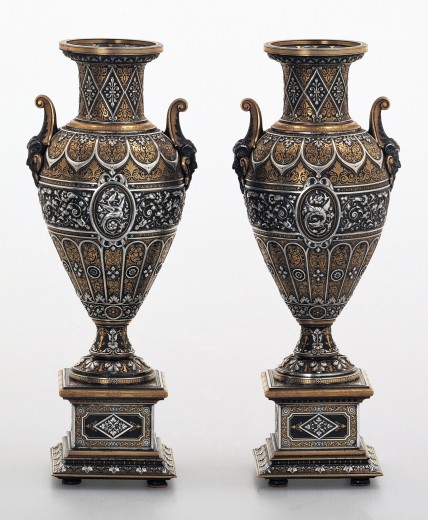



Title: Pair of Iron Urns
Date: circa 1875
Location: Spain, Eibar
Materials: forged iron, applied iron handles, gold damascene, silver appliqué
Dimensions: height 37.1 cm (incl. plinth)
Accession Number: ZUL 94
Other Notes:
In profile these urns are much like ZUL 104, but here their similarity ends. Apart from the treatment of some of the vegetal elements in the damascene, the overall ornament is entirely Western, inspired by Renaissance and baroque ornament in an obviously nineteenth-century interpretation. The body of the urns has again been divided into upper and lower decorative fields by a horizontal band, but in this case the band itself has become the decorative focus. It has been broadened, and contains chased silver ornament in high relief. Applied medallions both front and back are similarly decorated with figures of winged serpents. Panels outlined by raised silver mouldings are filled with gold damascened foliage and flowers in silver relief.
The applied iron handles show a different treatment. Their bases are chiselled in the grotesque masks with ram’s horns. Chiselled acanthus leaves rise from these to end at the handles’ spiral terminus. The chiselling remains undecorated except that, like the body of the urns, it has been blackened. However, here the background has been stippled and covered with gold leaf to set off the black relief. Several variants of this ornament will be seen on urns coming from Plácido’s school, where wolves’ and stags’ heads have been substituted for the masks.
These urns are certainly the ‘gold and dark steel vases, placed on a hall table’, at Carlton House Terrace; this description in The Magazine of Art would place them in the Morrison home at least by 1879.
Bibliography:
J. D. Lavin (ed.), The Art and Tradition of the Zuloagas: Spanish Damascene from the Khalili Collection, Oxford 1997, cat. 3, p. 88.
Zoom
Close

Create your own collection of artworks that you can print or save as a PDF. Please enter you email to enable feature.
Small Flask | JLY 1075
Has been added to your collection.
TIP:
You can now access and view your collection from the main menu at any time.